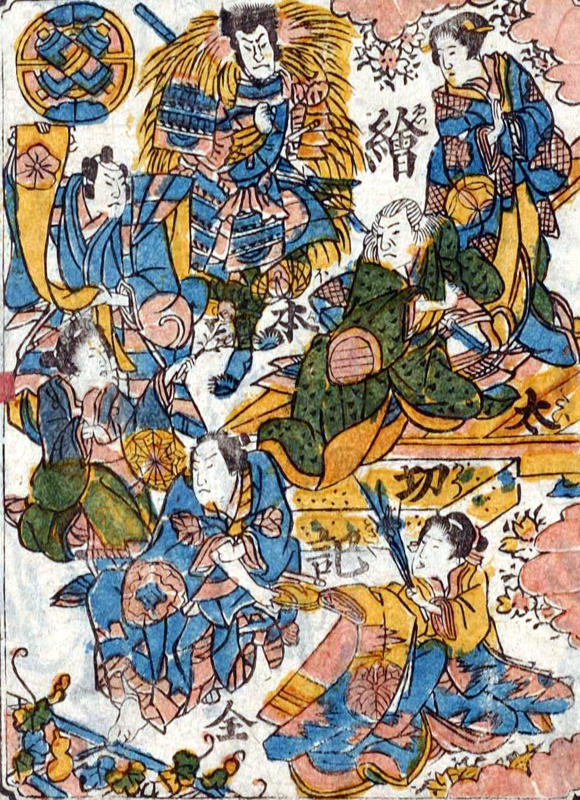| EHON TAIKďKI |
| Play titles | Ehon Taik˘ki Eh˘ Taik˘ki |
||||||||||
| Authors | Chikamatsu Yanagi, Chikamatsu Kosuiken, Chikamatsu Sen'y˘ken (1799 puppets version) Nagawa Tokusuke I (1800 Kabuki version) |
||||||||||
| History |
The play "Ehon Taik˘ki" was originally written for the puppet theater (Bunraku) and staged for the first time in the 7th lunar month of 1799 in ďsaka at the Toyotakeza. It was adapted for Kabuki the next year by Nagawa Tokusuke I, entitled "Eh˘ Taik˘ki" and staged for the first time in the 11th lunar month of 1800 in ďsaka at the Kado no Shibai [casting]. It was staged with the original title for the first time in the 7th lunar month of 1802 in Ky˘to at the Kitagawa no Shibai. The title "Eh˘ Taik˘ki" was still used in ďsaka up to the beginning of the 1820s. Because of strict censorship, the authors had to change the names of the characters:
"The play consisted originally of thirteen acts, one act for each day that passed between Akechi Mitsuhide's murder of Oda Nobunaga and his death at the hand of Toyotomi Hideyoshi. The tenth act is the only one which has survived. This act tells of an incident during the battle in which Mitsuhide was finally defeated. When Akechi Mitsuhide determined to murder Oda Nobunaga, he laid his plans carefully. He chose a time when Nobunaga was in Ky˘to with a bodyguard of not more than two hundred men, while his other forces were dispersed far from the capital. In particular, the two men Mitsuhide knew to be most likely to thwart his plans were, he trusted, in no position to resist him. Toyotomi Hideyoshi was away, laying siege to the castle of Takamatsu in Bicchű, the last stronghold of Nobunaga's enemy Mori Motonari. Ieyasu was awaiting Nobunaga at Sakai with a small contingent. Mitsuhide arranged for Sakai to be surrounded at the same time as he made his own coup. Ieyasu escaped capture through the friendly warning of a local tea-grower. Mitsuhide had, however, underestimated Toyotomi Hideyoshi. Having brought Takamatsu Castle to its last gasp, Toyotomi Hideyoshi was able to conclude a speedy truce with Mori. He hurried back to Ky˘to by forced marches, surprised Mitsuhide at Yamazaki, and defeated him. Legend has it that Toyotomi Hideyoshi killed Mitsuhide with his own hand, but, in fact, he was cut down by a peasant as he fled from the field." (Aubrey and Giovanna Halford in "The Kabuki Handbook") Only the tenth act became a classic of the Kabuki reportoire. The National Theatre had the good idea to produce a t˘shi ky˘gen revival of "Ehon Taik˘ki", staging acts 1, 2, 6, 9 and 10 in November 2005 [casting]. |
||||||||||
| Structure |
This play was originally made up of 13 acts (13 days). The 10th act, the "Amagasaki Kankyo" act, is still part of the Kabuki repertoire and is staged quite often. |
||||||||||
| Key words |
Gidayű Ky˘gen Jidaimono Mashiba Hisayoshi Oda Harunaga Sat˘ Masakiyo Sengoku Jidai Takechi Mitsuhide Taik˘ki Yamazaki no Tatakai |
||||||||||
| Summary |
|
 |
|
Illustration coming from the ezukushi banzuke for the staging of "Ehon Taik˘ki" in the 3rd lunar month of 1855 at the Kado no Shibai with Mimasu Daigor˘ IV, Jitsukawa Enzabur˘ I, Kataoka Ichiz˘ I, Nakamura Jakuemon I, Yamashita Kinsaku IV, Nakamura Daikichi III and Nakayama Nanshi II |
|
|
| Contact | Main | Top | Updates | Actors | Plays | Playwrights | Programs | Links | FAQ | Glossary | Chronology | Illustrations | Prints | Characters | Derivatives | Theaters | Coming soon | News |